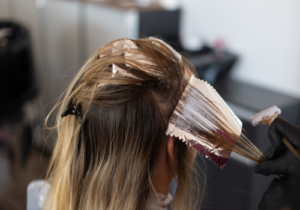"`html
Introduction to Hair Wax
Hair wax is a popular styling product that has won the trust of many hair styling enthusiasts. Used to tame unruly hair, structure a style or add a professional finishing touch, hair wax stands out for its effectiveness and versatility. This article explores the different types of wax available and the application techniques that can be used to achieve a natural styling effect, while examining the potential advantages and disadvantages of using hair wax.
Definition of hair wax
Hair wax is a styling preparation based on natural or synthetic waxes. Its generally thick, malleable texture enables a variety of hairstyles to be shaped while providing flexible hold. Depending on the formula used, wax can help texturize, add volume or smooth hair.
Types of waxes available on the market
- Water-based waxes : Easy to wash, they provide light to medium hold without greasy residue.
- Oil-based waxes : Offering a stronger hold, they are ideal for styles requiring maximum control.
- Matt waxes : Perfect for a natural look, they don't add excessive shine to hair.
- High-gloss waxes : Recommended for radiant, polished styling, they are ideal for dull hair in need of a luminous effect.
General use of hair wax
Hair wax adapts to a multitude of styles, thanks to a variety of styling techniques. Its application requires a few technical gestures to maximize its effect.
Application techniques and common hair styles
To avoid an oily appearance, we recommend applying wax to clean, dry hair. A small amount of the product is rubbed between the palms to warm it, and then applied evenly from roots to ends. Different techniques exist to optimize its use:
- For a tousled look: Apply messily with fingers to create volume and textured highlights.
- For a sleek look: Comb gently after application to smooth hair and eliminate frizz.
- For defined loops : Twist strands after application to define curls without hardening them.
- For short hair: Use wax to define and adjust strands for a structured, controlled style.
“`

"`html
Advantages of Hair Wax
Hair Control and Hold
Hair wax stands out for its ability to offer exceptional control and hold. It helps hold styles in place without compromising hair's natural suppleness, which is essential for a well-defined style all day long.
The natural hairstyle effect with wax
Unlike some gels or lacquers, which can give a stiff appearance, wax ensures a natural effect. It facilitates the reshaping of hair throughout the day, ensuring a casual, well-groomed look. It is particularly suited to those seeking to enhance the natural texture of their hair.
Ease of use and versatility
One of the main advantages of hair wax is its ease of use. Ideal for novices and experts alike, the wax can be incorporated into a variety of hair routines, adapting to different hair types and styles.
Comparison with other styling products
- Hair gels : Although gels are highly fixative, they can leave a sticky residue or cardboard effect, which is not the case with wax.
- Lacquers : Offer immediate hold, but lack the flexibility and matte or gloss finish that wax can provide.
- Foams : Ideal for volume, they don't offer the same reshaping potential that wax provides throughout the day.
Hair conditioning
In addition to its styling properties, hair wax offers additional conditioning, making it beneficial for dry or damaged hair. It helps moisturize and nourish hair fibers.
Moisturizing ingredients often used in hair waxes
- Beeswax : Naturally moisturizing and softening, it helps retain moisture in the hair.
- Vegetable oils : Like argan or jojoba oil, which nourish and add natural shine.
- Natural butters : Shea butter, for example, provides not only moisture but also supple hold.
In conclusion, hair wax proves to be a valuable styling product for those who want a long-lasting style with a natural, nourishing look. Its ability to serve as a styling product while conditioning the hair makes it an optimal choice for many users.
“`
See also: Does wax cause dandruff?
"`html
Potential disadvantages of Hair Wax
Accumulation of Products
One of the main drawbacks of regular hair wax use is the possibility of product build-up. Because of its thick texture, wax can build up on the scalp and hair, making it dull and difficult to style.
How to avoid and treat wax build-up
- Deep cleaning : Use a clarifying shampoo once a week to remove accumulated residue.
- Moderate quantity : Apply wax in small quantities to avoid excesses that cause build-up.
- Washing at the right speed: Make sure you don't wash too often to avoid wax build-up.
Fat Effect
Another frequent problem associated with waxing is the appearance of a greasy effect on the hair. This is often due to over-application of the product or poor distribution on the strands.
How to prevent greasy hair
- Apply to dry hair: Make sure your hair is completely dry before applying the wax to avoid a greasy effect.
- Mix with other products: To reduce the oily appearance, mix the wax with a small amount of gel or mousse.
- Use a water-based wax: These waxes tend to be less greasy than oil-based waxes.
Allergy risk
Although relatively rare, allergic reactions can occur in some people following the use of hair wax. These reactions may be due to certain ingredients in the wax's composition.
Symptoms of hair product allergies and how to avoid them
- Allergy signs : Itching, redness or rashes on the scalp can be indicators of allergy.
- Test before use : Perform a skin test before introducing a new product to identify any potential hypersensitivity.
- Choose hypoallergenic waxes: Opt for formulations designed to limit allergic reactions.
Using hair wax comes with a few challenges, mainly related to improper use or personal sensitivity to the ingredients. However, by taking certain precautions, these drawbacks can be minimized. It's crucial to know your own hair needs and choose the products that best suit your hair type and scalp.
“`

Care and Usage Tips for Hair Wax
Seasonal and climatic applications
Hair wax can be influenced by climatic conditions. In summer, high temperatures can make the wax more liquid and reduce its hold. It is therefore advisable to opt for a strong-hold wax during this season. In winter, taking care to use moisturizing waxes can help prevent dryness caused by cold, dry air.
Tips for different seasons
In summer, apply less wax to avoid a greasy look, and prefer products containing UV protection to protect your hair from sun damage. In autumn and winter, wax can be a useful tool to combat frizz-causing humidity, while adding a protective layer against the cold.
Choosing the right wax for your hair type
Choosing the right wax for your hair type is crucial to achieving the best results. For fine hair, light water-based waxes are recommended to avoid weighing down strands. Thick hair can benefit from oil-based waxes for better control.
Adapting wax to specific hair needs
If you have curly hair, look for waxes that contain moisturizing ingredients to maintain elasticity and curl definition. For color-treated hair, use waxes specially formulated to preserve color and prevent rapid fading.
Hair Care Routine with Wax
Frequent waxing requires special attention to hair care to ensure it stays healthy. It's essential to incorporate suitable hair care products into your weekly routine to counter any adverse effects perhaps caused by product build-up.
Tips for making wax part of your hair routine
Alternate the use of wax with other styling products to avoid dependency and residue in the hair. Use softening hair masks once or twice a week to deeply nourish hair. Finally, adopt a shampooing routine that encourages wax cleansing, notably by using clarifying products adapted to your hair type.
FAQ
- Does wax weigh down fine hair?
- Can I use the wax every day?
- Can wax help protect hair from the sun?
- What effect does wax have on color-treated hair?
- Is wax suitable for people with skin allergies?
Yes, heavy waxes can weigh down fine hair. Opt for a light, water-based wax to avoid this effect.
Daily use of wax can lead to build-up. We recommend spacing out applications and remembering to wash regularly.
Some waxes contain UV filters that can offer additional protection against sun damage.
Wax can be safe for color-treated hair if specifically formulated to protect color and include antioxidants.
Those with allergies should choose hypoallergenic waxes and perform a skin test beforehand to avoid reactions.





